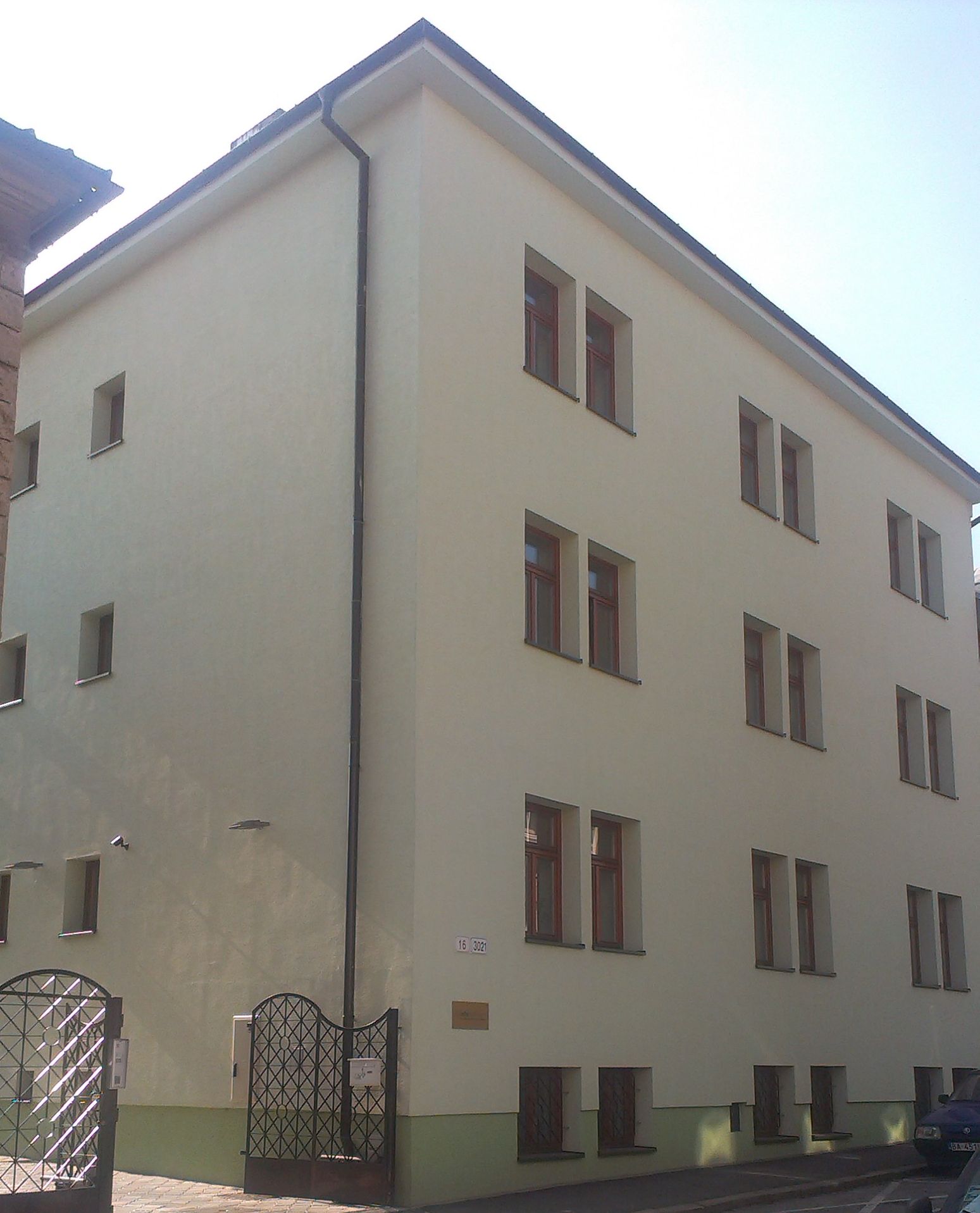History and current status of INFOSTAT
During almost 50 years of its existence, INFOSTAT has been passing over several phases of development that determined not only the scope of its activities, but also its status as a research organization with the nation-wide sphere of activities. The history of INFOSTAT can be characterized by three development phases:
Phase 1. Establishment and profiling of Institute (1968 – 1976)

The inception of Institute is referred to 1 July 1967, when based on the treaty between the government of the former Czech and Slovak Republic and the UN, the president of the State Statistical Office issued a decree on the establishment of the Computing Research Centre – Program UN (hereinafter Centre; Slovak acronym was VVS / OSN). The idea for this workplace arose in the European Economic Commission of UN. The objective was to support the development of modern information technology in the field of information processing within the socialist countries. The Centre was officially opened on April 24, 1969 as a research base of the State Statistical Office residing in Prague.
The participation of key experts from Europe, USA, Canada and Australia and internships of institute’s employees in advanced foreign research institutes, universities and statistical offices, together with the acquisition of the newest professional literature, all contributed to the rapid implementation of knowledge into the research products of the Centre. The transfer of foreign technology into the domestic environment and the involvement of employees in international research enabled the Centre to develop a staff of experts on contemporary information systems.
The research in the field of programming tools resulted into progressive products such as the PASCAL language compiler, which became a tool for the next generation of other programming products.
Phase 2. Expansion of Institute as a research and development workplace with a nation-wide scope of activities (1976 – 1990)

During the next 14 years the Centre recorded the highest expansion in all fields of activities – research, training of employees, co-ordination of research, development of international co-operation and the organization of state and international seminars and conferences. The Centre achieved a position of a state-wide leading workplace in the field of information systems developed for management.
During this phase, the year 1984 represented a significant milestone in the history of Institute, when based on the reorganization of the State Program on Economic Research, the Research Computing Centre had been abolished and instead the Research Institute of Socio-Economic Information and Automation in Management was established (Slovak acronym was VUSEI-AR) with an affiliated branch in Prague. In those times Institute was already in a position of a leading workplace in the field of information system development. Thus, it was entrusted by the government to co-ordinate the state plan of economic research in the field. At the end of 1989, the Institute employed 225 researchers and supporting staff.
Phase 3. Transformation of research and development activities under new socio-economic conditions (1991- present)
Since the beginning of 1990-ties, the activity of Institute has been influenced by three substantial factors:
- the decay of state research plan, what caused the reduction of funding and the change in the position of research institutes,
- the change in technical base characterized by a large-scale installation of PCs and firmware,
- breakup of the Czech and Slovak Federative Republic.
In 1991, the VUSEI-AR was renamed to INFOSTAT and since 1 January 1993 it moved from subordination of the Federal Statistical Office under the auspices of the Statistical Office of the SR (SOSR). At the same time its status from budgetary organization changed into a subsidized organization.
Although this organizational change did not change the entire professional scope of activities of Institute, together with the cessation of state research plan, it significantly influenced the content of research. The research program was primarily determined by the needs of the SO SR, which resulted from the transformation of state statistics to the conditions of market economy.
The transformation of the national statistical system to new conditions required the adoption of series of systemic measures. Based on the experience with the formation of conceptual materials, the Institute prepared the “Concept of the State Statistics Development of the SR”. Within its framework the Institute proposed the architecture of the statistical information system in order to increase the readiness, flexibility and openness of official state statistics.
A substantial difference as compared to the previous years, lies in the fact that the core activity of Institute, although the three basic directions (organization and projecting of IS, assessment of IS data, programming and technical tools for IS) were maintained, has shifted from research activities to development and implementation.
In the field of organization and projecting the activities of the Institute evolved in two basic directions:
- innovation of statistical methodology to fit the new market conditions and to facilitate harmonization with EUROSTAT statistics,
- reconstruction and upgrade of data processing technology
The linkages between specific parts of the statistical information system were solved in the architecture of the Automated Statistical Information System (ASIS). The basic architecture was composed from five mutually interlinked subsystems: meta-information, statistical registers, source and production database, statistical data collection and the subsystem on presentation and dissemination of statistical information. After adoption of this concept, the projecting of relevant subsystems started in co-operation with the SO SR.
The decreasing amount of subsidies from state budget forced the Institute to devote some of its capacity to commercial activities. Consequently, in the following years INFOSTAT played an essential role in the development of the new tax administration system, the health insurance information system, the R&D potential evaluation system for the Ministry of Education, and many others.
During the more recent years the Institute had been solving four international projects organized by Eurostat, the aim of which was to innovate and harmonize the selected statistics in Middle and East European countries.
Institute has been recently co-operating with foreign and international organizations. It collaborates with Eurostat, French Statistical Office, CESIA, ISTAT, or the Hungarian Central Statistical Office, just to mention the more important ones. The Institute is a member of ICA (International Council for Information Technology in Government Administration), of conference ICAGO. The employees of Institute are members International I/O Association and are involved also in the project LINK, a world system of econometric models led by the UN Department of International Economic and Social Relations.
In addition, INFOSTAT has successfully revived its education and training activities. In co-operation with experts from Netherlands and United Kingdom it applied a complex system of training of experts for information technologies based on the educational systems well-tested in western countries (AMBI system) and well-experienced methods for the generation of information systems (methods SSADM and PRINCE). A concept for advanced training in statisticians was developed and INFOSTAT has been commissioned to act as an educational training center for the SO SR. The institute has trained 180 employees of SO SR for the work with new software products.
 Based on its contemporary activities it is not an overstatement to say that the Institute successfully maintains an experienced team of researchers who can compete in the Slovak as well as in the European market place in the fields large scale IT project coordination and management, development and implementation of large scale, sophisticated information systems aimed at collection, processing and analyzing large amounts of data. After all INFOSTAT is the institution which generates “Information with meaning.“
Based on its contemporary activities it is not an overstatement to say that the Institute successfully maintains an experienced team of researchers who can compete in the Slovak as well as in the European market place in the fields large scale IT project coordination and management, development and implementation of large scale, sophisticated information systems aimed at collection, processing and analyzing large amounts of data. After all INFOSTAT is the institution which generates “Information with meaning.“
In short, during almost 50 years of its existence, more than 1300 employees passed through the corridors, computer rooms and laboratories of the research institute not only contributing to its reputation, but also gaining research experience and professional skills unmatched in the region. It cannot be a coincidence that the Institute not merely survived, but was also able to keep up the pace and even dictate the advancement of new technologies in the field of statistics through five decades of economic turbulence, dynamic scientific advancement and regime changes. For all colleagues the affiliation with the institute became a sort of a quality certificate when applying for another job.
